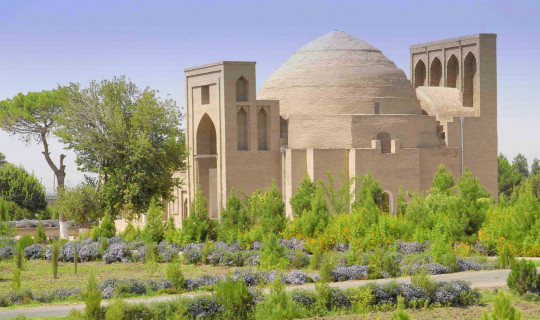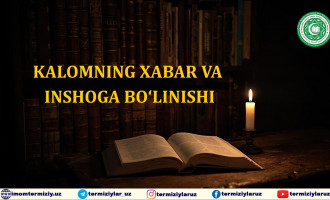
HAKIM TERMIZI SHRINE
Hakim Termizi shrine (X-XIV centuries), located on the banks of the Amu Darya in the district of Termez, is named after al-Hakim at-Termizi, the father of the Surkhandarya School of mysticism. This architectural monument, which is belonged to the X-XIV centuries and built in Termez district, is associated with the name of Abu Abdullah Muhammad ibn Ali ibn Husayn al-Hakim at-Termizi (passed away (d) 869 years) who lived, worked and was a founder of the development of healer’s job, famous scientist from Termez, author of a number of religious and philosophical works, a great hermit in the IX century. Hakim Termizi was one of the scholars who had a deep knowledge of not only the external but also the internal sciences. He was called with assumed names as “Al-Hakim”, “Donishmand Termiz ata”, “at-Termizi” because he was from Termez.
The popularity of the shrine named after this person is glorified not only in the region, but also in the Islamic world as “Termez ata”. It narrated that the parents of this scholar were aware of the science of hadith, so he received his primary education from them. The scholar studied in the cities of Movarounnahr until the age of 25, and at the age of 27 set out for Mecca to perform the Hajj. Along the way, they will visit the cities of Kufa, Baghdad and Basra, where the science of hadith is developed, and are acquainted with the poems of Asim al-Antaki and Ahmad ibn Hizruya who is sufi from Balkh. Hakim Termizi strongly influenced by his scientific and literary works. A number of Sufis, notably Abu Turab al-Nahshabi (d. 861) and Yahya ibn Jamal and Ahmad ibn Hizruya (d. 855) educated him. Hakim Termizi lived in a time when mystical views were formed in the central cities of the Islamic world, such as Mecca, Medina, Egypt, Baghdad, Basra, Kufa, Yemen, Hamadan, Nishapur. Where the ideas of the first Sufi movement, asceticism and enlightenment were strengthened, and also talked to Sufi scholars in Damascus, Baghdad and Egypt that played an important role in his scientific maturity. He became famous among the scholars who worked in Bayt al-Hikma, where The Caliph Ma'mun established as a scientific center in Baghdad. He was known as Kidwat ul-Awliya, the Leader of the Saints. There is controversial information that Hakim Termizi wrote more than 400 works, of which only 57 have survived. Some of them are currently stored in the UzR FASHI Manuscripts Fund of the Republic of Uzbekistan, in city libraries such as Paris, Cairo, Damascus, Alexandria, Istanbul, London. For instance, “Kitob an-najoh” (the book of ways), “Xatm al-avliyo” (the stamp of valies), “Irshod at-tolibin” (instruction for students), “Kitob haqiyqat al-odamiya” (the book about human truth), “Adab un-nafs” (temptation morality) have been essential ones till now.
Hakim Termizi’s theory includes three branches: the ways of praying and religious events, tasawwuf, and religious belief. Having returned to Termez, Hakim Termizi had a mosque and mausoleum built choosing a place from the highest hill, the most picturesque and airy coast where the city of Balkh and the Prophet’s Island of Jayhun can be seen. This mausoleum was erected in Old Termez, on the banks of the Amu Darya, where scholars gathered, and the scholar was buried in this mausoleum.
The mausoleum of Hakim at-Termizi is a cult memorial complex of the IX-XV centuries, which includes a mosque, a mausoleum, a khanaqah and a sagan. According to the results of the research, a mosque with a porch built in the northwestern part of the mausoleum in the IX century; it was made of polished baked brick, and there are written ornaments from this brick itself. In the early thirteenth century, its courtyard was formed and a single-domed mausoleum was built. At the end of the 14th century, a chillakhana was built on the east side of the mausoleum in 792 AH (1389/1390). While the mausoleum was 5.10x4.70 m in size, the total size of the monument was 28x29 m. In 1955-1957, the mausoleum of Hakim Termizi scientifically studied and its appearance in the XIV-XV centuries was restored. The Termez mausoleum can be considered as a historical monument of the XIV-XV centuries.
There is also a mosque next to the dahma, which, according to its size, is 4 m long, about 2 m high and about 1 meter wide. The mausoleum is restored from white marble slabs and consists of numerous inscriptions and ornaments. Its narrow lateral cross-section consists of various niches in terms of composition. The building consists of wooden columns, sloping doors, ceilings, altar, mosque, wooden tombstone inscriptions. Maple, elm, spruce and poplar were used for the architecturally decorated wood of the building. The prayer halls in the Hakim Termizi complex combine many mosque-terraced complexes, the terrace is in a U- shape, and the mosque consisted of only the terrace in 10th century. The porch and the yard of the center-aspirating domed mausoleum were connected to the mosque. The mausoleum is arched in the shape of a square, and inside it is decorated with open arched roofs. At the end of the 11th century, according to the order of the Karakhanid ruler Abul Muzaffar Ahmad Tigatigin (1081/1095), the inside of the dahma was covered with magnificent carved bricks.
A small mosque is attached to the northern side wall of the mausoleum. The structure of the mosque is similar to the architecture of the Bukhara mosque. It has three domes, and the open arched roof leads to a bricked courtyard. The place where Hakim Termizi was buried was one of the central Buddhist temples before the Arab invasion. It was considered as the Termez temple of the IX century. Later, large graveyards appeared around the tombs of these two scholars. Historian Mahmud ibn Vali (XVII) also noted that the sacred mausoleums of Hakim at-Termizi and Abu Bakr al-Varraq were close to the wall of Old Termez and were located on the north side of the castle in his notes.
In 2001-2002, on the 2500th anniversary of the city of Termez, the government reconstructed the shrine of Hakim Termizi. In 2008-2010, the Ministry of Culture and Sports of the Republic of Uzbekistan carried out restoration work at the expense of the budget and under the auspices of the Republican Railway Company. In 2010, under the leadership the Prime Minister of the Republic Sh. M. of Mirziyoyev, great beautification works were carried out at the shrine. From August 2016 to May 2017, the Department of Archaeological Monuments of the Ministry of Culture and Sports of the Republic of Uzbekistan on a budgetary basis reconstructed it.
Abdumalik Maksudov – Imam Termizi is a student of the secondary special Islamic educational institution
Ta’lim muassasasi matbuot xizmati
 УЗ
УЗ
 РУ
РУ
 EN
EN
 العربية
العربية






Izohlar